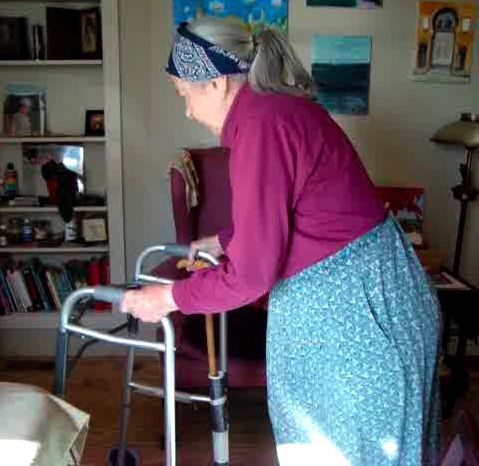by Beth Whitman
Some 25 years ago Mom made the decision not to have knee replacement surgery, despite the repeated urgings of my father and us kids.
Mom never put much stock in modern medicine and was one of the early followers of natural foods and alternative medicine. It’s not so much that she disavowed medical doctors, but to her, the qualities of caring and open-mindedness in a doctor were paramount, and once she found a doctor she liked, she would stay with that doctor even if it meant having to travel to a different state. So, at the age of 65, Mom just didn’t want to face the traumatic prospect of new doctors and invasive surgery.
The cartilage in her knees was pretty much gone — a condition known as osteoarthritis — probably from all those years of running up and down Mount Washington, wearing a heavy pack, delivering supplies to the Appalachian Mountain Club Huts. Mom had been a “Happy Appie,” and she and her sister Liz instilled in me an independent and adventurous outdoor spirit that took me into the High Sierra and other wildlands of the West when I was in my 20’s and 30’s.
As she grew older, Mom preferred to simply move slowly with her stiff, arthritic legs rather than go through corrective surgery. Thus, stiff-legged walking became her trademark gait, and it grew more and more labored as her Alzheimer’s progressed, until she couldn’t stand up at all.
She had her favorite cane, and as long as people weren’t moving fast, or knocking into her, she was fine. Even though she would be considered a very high “fall risk” by current predictive models, she never fell while she was with me.
At some point she looked unsteady enough that medical professionals advised she use a walker. But she was attached to her cane, and even though I taped a plastic PVC tube onto the front right leg of the walker so she could sort of hold onto the walker and the cane at the same time (see photo), she never really made the shift to the four-legged stabilizer.
It got to the point, though, where the cane stopped working for Mom altogether because she didn’t remember how to hold it and would put the handle on the floor rather than the rubber tip. She then began to drag the walker alongside her, as if it were an overly large cane. My solution was to rearrange the furniture, to put a series of chairs and tables within reach of her every step so she could move around the room from object to object. Naturally, Mom continued to innovate — whenever she found a particularly stable object that was light enough to move, she would drag it around the house as a surrogate cane.
One day, when she had grabbed the folding commode for stability and was slowly dragging it across the room, she suddenly stopped and couldn’t remember how to take another step. At that point I was surveilling her 24/7, employing a video monitor so I would know when she needed assistance, and I had seen her crossing the room and then halt right in the middle.
I went in and encouraged her to take another step. I touched her leg, as a way to remind her which foot to move forward, and I could see her try to lift it off the floor, but it just didn’t happen. She stood there, trying, first one leg, then the other, lifting each one ever so slightly, but never managing to take a step.
Ten minutes passed. Then thirty. I brought a chair in and placed it behind her, and asked her if she might want to sit down instead.
But she didn’t WANT to sit down. She WANTED to keep moving.
An hour went by, and I decided that I needed to do something. I got one of the overstuffed chairs from the living room and put it behind her in place of the smaller wooden chair. I put it right up to the back of her knees so she could feel it. She was starting to look at me with desperation in her eyes. And as I lifted her hand off the commode and gently pushed her off balance, a look of fear crossed her face. But upon landing safely in the large cushioned chair, her expression changed to relief, and then exhaustion, and within minutes she was asleep.
Beth Whitman lives in Maine and is a member of Belfast Cohousing and Ecovillage, a developing community on the coast of Maine focused on multigenerational living and sustainability.






